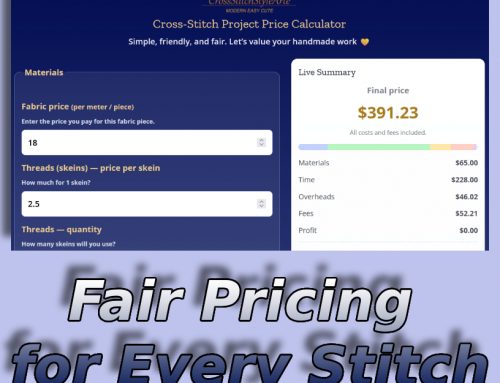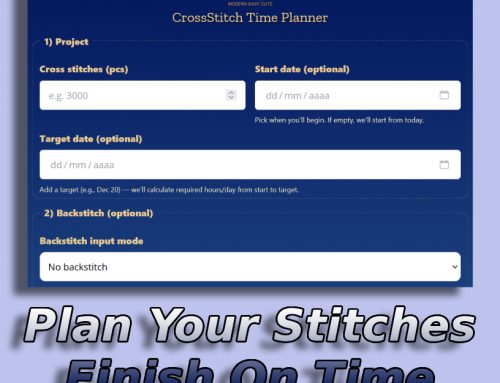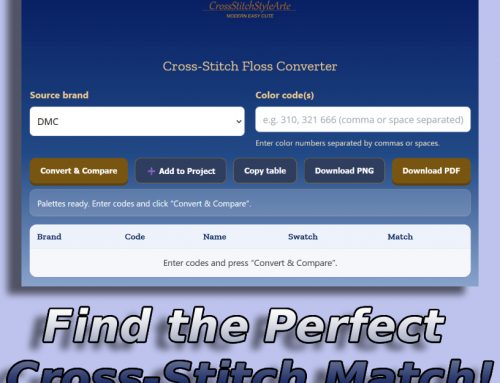How to Choose the Right Fabric for Your Cross-Stitch Project
Choosing the right fabric is a crucial step in ensuring the success of your cross-stitch project. The type of fabric you select will affect the overall appearance, ease of stitching, and durability of your work. This guide will help beginners understand the different types of fabrics available and how to choose the best one for their cross-stitch pattern.
1. Understanding Fabric Count
Fabric count refers to the number of threads per inch of fabric, and it is a key factor in determining the size of your stitches. A higher count means smaller stitches, while a lower count means larger stitches. Common fabric counts include 14, 16, 18, and 28.
– 14-count fabric: This is the most commonly used fabric for beginners. It means there are 14 threads per inch, making the stitches larger and easier to see.
– 16-count fabric: A slightly higher count that creates smaller, more delicate stitches, suitable for more detailed work.
– 18-count fabric: Even finer than 16-count, ideal for intricate designs where precision is key.
– 28-count fabric: Often used for more advanced projects, this fabric usually requires you to stitch over two threads to create the equivalent of a 14-count design.
2. Types of Fabrics
There are several types of fabrics you can use for cross-stitching, each with its own characteristics and uses.
– Aida Fabric: The most popular fabric for cross-stitch, Aida is a stiff, open-weave fabric that makes it easy to see where to place your stitches. It comes in various counts, most commonly 14-count, making it ideal for beginners. Aida fabric is known for its easy-to-count squares, which help maintain stitch consistency.
– Evenweave Fabric: Evenweave fabrics, such as Lugana or Jobelan, have an even distribution of threads both vertically and horizontally, allowing for more uniform stitches. This fabric is typically used for more advanced projects and is often selected for its smooth texture and finer appearance. Common counts include 25, 28, and 32.
– Linen Fabric: Linen is a high-quality fabric with a natural look, often preferred by experienced stitchers. It has an uneven weave, which can make it more challenging to work with, but it offers a beautiful finish. Linen is usually used for more intricate and traditional designs.
– Perforated Paper: This is a unique option for cross-stitching smaller, decorative items like bookmarks, ornaments, or greeting cards. It is sturdy and does not fray, making it easy to work with for specific projects.
3. Consider the Project Size and Complexity
The complexity and size of your project should guide your fabric choice. For large, detailed designs, you might opt for a finer fabric like 18-count Aida or 28-count Evenweave, which allows for more detailed work within a smaller area. For simpler, smaller designs, a 14-count Aida fabric may be more appropriate.
4. Color of the Fabric
The color of your fabric plays a significant role in the final appearance of your project. Most cross-stitch fabrics come in a range of colors, from classic white and cream to more vibrant hues.
– Neutral colors: White, ivory, and beige are the most commonly used fabric colors, allowing the threads to stand out clearly.
– Colored fabrics: These can add depth and background to your design, especially if you’re working with designs that incorporate a lot of negative space.
– Hand-dyed fabrics: For a more unique look, you can choose hand-dyed fabrics that offer a mottled or variegated background, adding an artistic touch to your project.
5. Fabric Stiffness and Finish
Some fabrics come with a stiff finish, which can be helpful for beginners as it makes handling the fabric easier. However, if you prefer a softer, more flexible fabric, you may want to wash and iron it before starting your project to remove some of the stiffness.
– Stiff fabric: Easier to handle, especially if you don’t use a hoop or frame.
– Soft fabric: More flexible and comfortable to work with, especially for larger projects that may take a long time to complete.
6. Budget Considerations
Your budget might also influence your choice of fabric. Aida is generally the most affordable and widely available option, making it a good choice for beginners or those working on a budget. Evenweave and linen fabrics tend to be more expensive but offer a higher-end finish that might be worth the investment for special projects.
7. Purchasing Tips
When buying fabric, consider purchasing a piece larger than your design requires. This extra fabric allows for framing and finishing the project without running out of material. Also, make sure to store your fabric properly, keeping it away from direct sunlight and moisture to avoid discoloration or damage.
Conclusion
Choosing the right fabric for your cross-stitch project can significantly impact the outcome of your work. By understanding fabric count, types of fabrics, project size, color, stiffness, and your budget, you can make an informed decision that best suits your design and skill level. Whether you’re a beginner or a seasoned stitcher, selecting the appropriate fabric is the first step toward creating a beautiful and satisfying cross-stitch project.
Happy stitching!
Here you can find other cross-stitch tutorials and masterclasses for beginners and beyond.
























Leave A Comment